Archive:Employment - quarterly statistics
Data extracted in January 2021
Planned article update: April 2021
Highlights
The recent health crisis due to the COVID-19 pandemic has impacted employment in the European Union. In order to keep the expected negative consequences of the COVID-19 crisis on employment and businesses at bay, measures (such as short-time work and financial support to enterprises) have been implemented in some EU Member States since March or April 2020. In the first weeks of the crisis due to the COVID-19 pandemic, this kept employed people relatively secure in their jobs thus, avoiding mass layoffs. However, this first stage was already marked by reduced inflows into employment. Enterprises might have slowed down, revised or cancelled their hiring process or might have decided to not renewing fixed-term contracts or probationary periods for example. These specific effects affecting directly young people were clearly visible during the second quarter of 2020 as further explained in this article. The third quarter of 2020 is characterised by the end of the lock down and the upturn of activity. However, the recovery has not yet been visible on the labour market, specially for young people. This quarter is also marked by the come back of people in the labour force, sometimes in default of employment.
This article focuses on the changes in employment observed during the crisis due to the COVID-19 pandemic based on the quarterly data from the Labour Force Survey. It shows the recent and long term developments as regards employment, mostly on a global European level but also specifically according to gender, age and level of educational attainment. A specific analysis dedicated to the evolution of temporary contracts and part-time work, including underemployed part-time workers, is also presented in this article.
Another article complements this article with a detailed analysis on the evolution of the employed population by occupation, sector of economic activity, age, level of educational attainment and professional status, by EU Member State. Both articles are part of the publication Labour market in the light of the COVID-19 pandemic. The current version of these articles focuses on the evolution of employment from the last quarter 2019 to the third quarter of 2020 i.e. from October-December 2019 to July-September 2020. In March 2021, they will be reviewed in order to include data on the fourth quarter of 2020.
Note: This article mainly uses seasonally adjusted data. Given that the adjustment model applies to the whole time series, figures released for previous quarters may have changed with the inclusion in the model of this last quarter (third quarter of 2020). Please also take note that figures presented in this article may differ in some cases from the source data due to continuous revision of the Eurostat database (Employment and unemployment (Labour Force Survey)).
Full article
Employment in the EU-27 sharply impacted although an upturn in Q3 2020
After the strongest decline ever recorded since 2000, the employment rate rose by 0.3 p.p. from the second to the third quarter 2020,
Since 2013, the share of employed people in the total EU population kept on growing from one quarter to the next until the third quarter of 2019 (using seasonally adjusted data), when it lost 0.2 p.p. compared with the previous quarter for the first time in six years. The employment rate remained consecutively stable in the two next quarters (from the third to the fourth quarter of 2019 and from the fourth quarter of 2019 to the first quarter of 2020). However, from the first quarter of 2020 (Q1 2020) to the second quarter of 2020 (Q2 2020), the share of people in employment went down from 73.1 % to 72.1 % (-1.0 p.p.), recording the sharpest cut since 2000 (see Figure 1). From the second to the third quarter of 2020, the employment rate rose by 0.3 p.p., far from compensating the decrease recorded in the previous quarter.
Moreover, the employment of men and women decreased to different extent between Q4 2019 and Q3 2020. In the last quarter of 2019, 78.9 % of the total male population and 67.3 % of the total female population aged between 20-64 were employed, this share went down to 78.1 % in the third quarter of 2020 for men (-0.8 p.p.) and to 66.6 % for women (-0.7 p.p.).
A relevant finding is about the labour force (also called the active population), which includes both employed and unemployed people. It is worth noting that the share of the labour force in the total population, after a cut by 0.8 p.p. between the first to the second quarter of 2020 reached 78.0 %. Unlike employment, it therefore almost regained the same level as in Q4 2020 which was 78.1 %. This might be explained by the number of people who likely gave up their job search during Q2 2020 so, did not fulfill the ILO criteria to be considered as unemployed and part of the labour force and who started again to look for a job in Q3 2020 and reintegrated the labour force.

(people aged 20-64, Q1 2000 - Q2 2020, in % of the total population)
Source: Eurostat (lfsi_emp_q)
In the third quarter of 2020, 72.4 % of people aged 20-64 were employed in the EU. In terms of comparison, in the first quarter of 2000, which is the starting point of the time series, less than two thirds of the total population aged between 20 and 64 was in employment (65.2 %). The increase over these last 20 years is mainly explained by the substantial and steady growth of the employment of senior people (aged 55-64) until the second quarter of 2019, increasing from 34.7 % in Q1 2000 to 59.2 % in Q2 2019 when it remained stable. It nevertheless increased again to reach 59.7 % in Q1 2020 as can be observed in Figure 2. However, the employment rate of seniors decreased in Q2 2020 as further explained in this article.
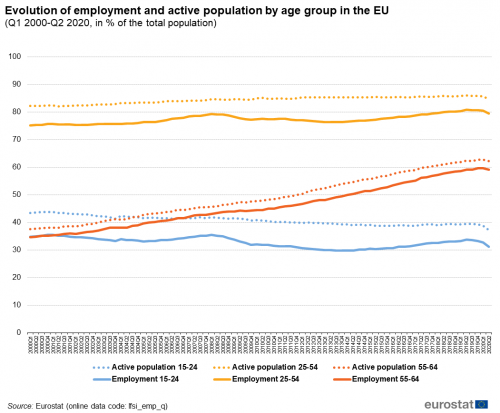
(Q1 2000 - Q2 2020, in % of the total population)
Source: Eurostat (lfsi_emp_q)
Decline in the employment rate in the vast majority of EU Member States
In the third quarter of 2020, there were only two EU Member States where the employment rate of people aged 20-64 was above 80%, namely Sweden and Germany (80.4 % for both) (see Figure 3). Please refer to the methodological note on German data related to Q1, Q2 and Q3 2020 in the section "Data sources". By contrast, the lowest employment rates were reported in Greece (61.2 %), Italy (62.2 %) and Spain (65.6 %), where fewer than two out of three persons were employed in the same period.
Actually, 24 out of the 27 Member States registered a lower level of employment in the total population in Q3 2020 compared with Q4 2019. However, the employment rate fluctuated to different extent among the EU Member States between these two quarters. In Estonia, the employment rate went down from 81.1 % to 78.0 %, corresponding to a decrease of 3.1 p.p. Decreases of 2 p.p. or greater were also registered in Spain (-2.0 p.p.) and Lithuania (both -2.4 p.p.). In Luxembourg, Bulgaria, Italy, Cyprus, Sweden, Ireland and Portugal, the decrease was between 1 p.p. and 2 p.p. By contrast, the employment rate increased by 0.8 p.p., 0.4 p.p. and 0.2 p.p. respectively, in Malta, Poland and Germany.
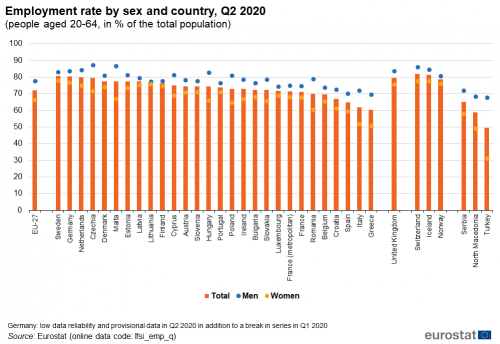
(people aged 20-64, in % of the total population)
Source: Eurostat (lfsi_emp_q)
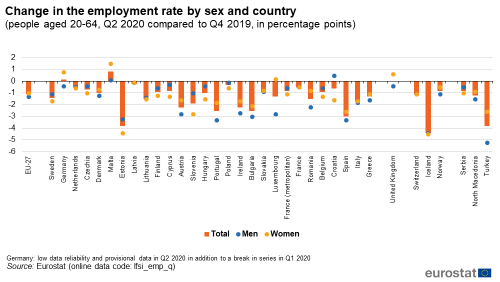
(people aged 20-64, Q2 2020 compared to Q4 2019, in percentage points)
Source: Eurostat (lfsi_emp_q)
Differences in the evolution of the employment rates of men and women are more or less pronounced across countries, and not systematically in favour of men or women, as displayed in Figure 4. Among the 20 EU Member States where the male and female employment rate decreased differently, four recorded a gap between the evolution of their male and female employment rates higher than or equal to 1 p.p. For example, in Portugal, the employment rate decreased by 3.0 p.p. for men but by 0.9 p.p. for women, showing the highest difference between men and women among the EU Member States for which the employment rates decreased (2.1 p.p. difference). Also in Luxembourg, although to a lesser extent, the male employment rate dropped by 1.9 p.p. while the female employment rate decreased by 0.3 p.p. (1.6 p.p. difference). By contrast, the decrease of the female employment rate exceeded by 1.1 p.p. the decrease recorded for men in Slovenia and Cyprus.
Young people are the worst impacted
Employment rate of young people went down in all EU Member States, from -0.2 p.p. in Luxembourg to -6.3 p.p. in Slovenia
In the European Union, employed young people aged 15-24 accounted for 14.4 million people, which corresponds to 7.5 % of the total employed people, in the third quarter of 2020. This proportion was 7.9 % three quarters earlier, in Q4 2019.
Since the third quarter of 2015 until the third quarter of 2018, the employment rate among young people (aged 15-24) increased continuously from one quarter to the next, reaching 33.7 % in Q3 2018. Then, it decreased by 0.1 p.p. in Q3 2019 and rose again to reach 33.8 % in the second quarter of 2019. Then, it started declining showing these consecutive decreases: -0.1 p.p. in Q3 2019, -0.4 p.p. in Q4 2019 and -0.5 p.p. in Q1 2020. In the next quarter, Q2 2020, the employment rate registered a drop of 1.6 p.p., and went down to 31.2 % which was by far the most substantial variation recorded from a quarter to another for young people since 2000. In the third quarter of 2020, employed young people stood for 31.3 % of the total population aged between 15-24, so +0.1 p.p. compared with the previous quarter.
The decrease between Q4 2019 and Q3 2020 is quite similar for young men and young women. While the employment rate shrank for young men by 1.9 p.p. between Q4 2019 and Q3 2020, reaching 33.7 % in Q3 2020, it decreased by 2.1 p.p. for young women, reaching 28.8 % in Q3 2020 (see Figure 5).
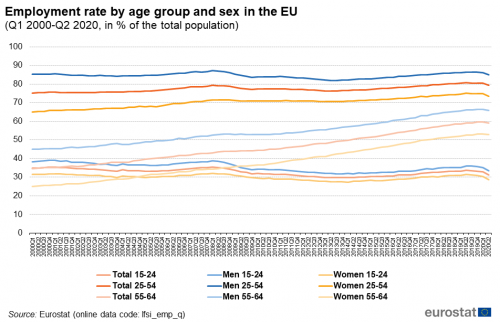
(Q1 2000 - Q2 2020, in % of the total population)
Source: Eurostat (lfsi_emp_q)
Among EU Member States, more than half young people were employed in the third quarter of 2020 in the Netherlands, in Denmark and in Austria (61.6 %, 53.5 % and 50.8 % respectively) while in Bulgaria, Spain, Italy and Greece, less than two out of 10 people aged between 15 and 24 were employed over the same period (see Figure 6). All EU Member states registered a decline the employment of young people. The most substantial drops in the employment rate between Q4 2019 and Q3 2020 were reported by Slovenia, Sweden and Portugal where the decrease exceeded 5 p.p (-6.3 p.p. in Slovenia, -5.4 p.p. in Sweden and -5.3 p.p. in Portugal). These results can be seen in Figure 7. Three other countries registered a decrease between 4 p.p. and 5 p.p. i.e. Poland (-4.5 p.p.), Lithuania (-4.6 p.p.) and Ireland (-4.7 p.p.).
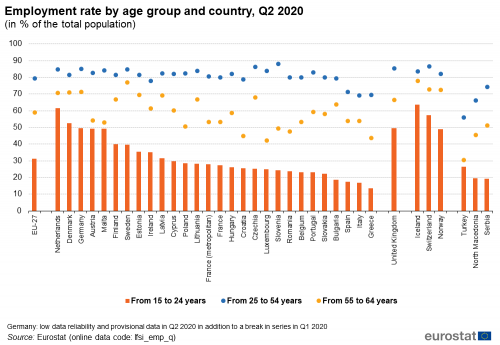
(in % of the total population)
Source: Eurostat (lfsi_emp_q)
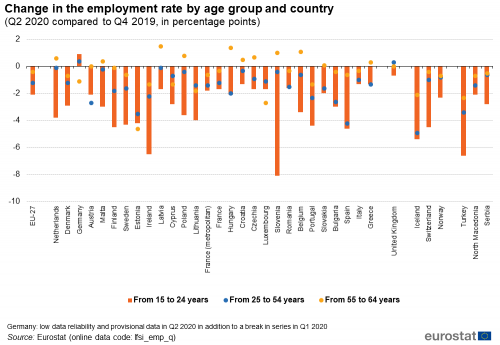
(Q2 2020 compared to Q4 2019, in percentage points)
Source: Eurostat (lfsi_emp_q)
Moreover, in the EU, almost three in four employed people (73.7 %) were aged between 25 and 54 in the third quarter of 2020 as well as in the last quarter of 2019. This age category stood for 140.9 million people in Q3 2020. Among people in this middle age group, 79.8 % were employed in Q3 2020 against 80.6 % in Q4 2019 as well as in Q1 2020 and 79.4 % in Q2 2020. For men aged 25-54, the rate went down between the last quarter of 2019 and the third quarter of 2020 from 86.3 % to 85.6 %, while for women aged 25-54, it dropped from 74.9 % to 74.0 % over the same period.
Regarding people aged 55-64, they stood for 35.9 million people in Q3 2020, which means 18.8 % of the total employed people. Actually, this proportion rose compared to the last quarter of 2019, when they accounted for 18.3 % of the total employed population. Over almost 10 years between Q4 2009 and Q1 2020, the sustained growth of the share of employed people aged 55-64 from one quarter to the next was clearly visible at EU level (apart from Q2 to Q3 2019, when it remained stable). This upward trend in the share of workers aged 55-64 is partially explained by the job retention for this sub-population, insofar as effective retirement age has risen in many countries in the last two decades. However, in 2019, the employment rate for people aged 55-64 did not grow between the second and the third quarter, despite having been common to record growth around 0.4 p.p. from one quarter to the next in previous years. From Q3 2019 to Q4 2019, the share of employed people aged 55-64 increased by 0.4 p.p., reaching 59.6 % in Q4 2019. Approximately, the same employment level of people aged 55-64 has been maintained to the next quarter (i.e. 59.7 % in Q1 2020). And for the first time since Q3 2009, the proportion of employed people in the population aged 55-64 decreased in Q2 2020, precisely by 0.5 p.p., reaching 59.2 % in that quarter. However, from the second to the third quarter of 2020, the employment rate grew again by 0.5 p.p. and retrieved its highest level ever recorded i.e. 59.7 %).
Men aged 55-64 registered a decrease of 0.1 p.p. between Q4 2019 and Q3 2020, resulting in 66.3 % of the male population aged 55-64 being employed in Q3 2020, while women of that age recorded a rise of 0.3 p.p., leading to 53.4 % of women aged 55-64 in employment in Q3 2020. This age category might have been less affected by the halt in recruiting during the lock-down than young people and in the first stages of the economic crisis, but may be more fragile against mass dismissals in the medium and long term.
Disparate employment rates for men and women with low, medium and high educational attainment level
The employment evolution by sex and educational attainment level over the period Q1 2005 - Q2 2020 shows noticeable differences, both for men and women (aged 20-64), according to their level of educational attainment (see Figure 8). First, the employment rate of men with a high educational level (i.e. tertiary education) is always higher than the employment rate of men with a medium (i.e. at most upper secondary or post-secondary non-tertiary education) or low educational level (i.e. less than primary, primary or lower secondary education, at most). This was also the case for women. In the same way, people with a medium educational level are proportionately more employed than people with a low educational level. Finally, the lower the educational attainment level, the wider the gap between the employment rates of men and women.
As regards people with a high educational level, they accounted for 32.1 % of the total population but for 37.5 % of the total employment in Q2 2020. Men and women follow roughly the same developments over time, and maintain a permanent gap between their respective employment rates. Nevertheless, the gender employment gap for those with a high educational level slightly narrowed over time: from 7.9 p.p. in Q1 2005 to 6.1 p.p. in Q2 2020. In the second quarter of 2020, 86.9 % of men and 80.8 % of women with a high educational level were employed.
Focusing on men and women with a medium level of educational attainment, they stood for almost half of the total population (47.5 %) as well as of the total employment (47.2 %) in Q2 2020. Their employment rate also followed the same trend over the period Q1 2005 - Q2 2020, although the fluctuations can be slightly more or less pronounced for men or women. The employment rate of women with a medium educational level was never above or equal to the one of men. A gender employment gap was present over the whole period Q1 2005 - Q2 2020. It corresponded to 13.3 p.p. in Q1 2005, the record "low" was 11.4 p.p. in Q1 2014 and in Q2 2015, and finally the employment gap between men and women reached 12.5 p.p. in Q2 2020. In the second quarter of 2020, almost eight out of ten men with a medium educational level (77.4 %) were employed against fewer than two thirds of women (64.9 %).
People with a low level of educational attainment represent 20.3 % of the total population at EU level in Q2 2020. However, referring to the population in employment, the low educational level category only accounted for 15.3 %. This means that people having only attained a low level of education had less chance in Q2 2020 to be in employment that people with a higher level of educational attainment.
The employment rate of men with a low educational level corresponded to 64.7 % in Q2 2020. In other words, this is slightly less than two out of three men with a low level of educational attainment who were employed in the second quarter of 2020. For women, the employment rate was 43.0 %, meaning that less than half of women with a low educational attainment level were employed. The gap between men and women was 26.1 p.p. in Q1 2005, shrank to 18.5 p.p. in Q3 2013, and widened again to 22.0 p.p. in Q1 2020. Between Q1 and Q2 2020, it slightly went down again to 21.7 p.p. As for people with a medium educational level, the gender gap narrowed when the total employment was reducing and it widened when the total employment was on the upswing.
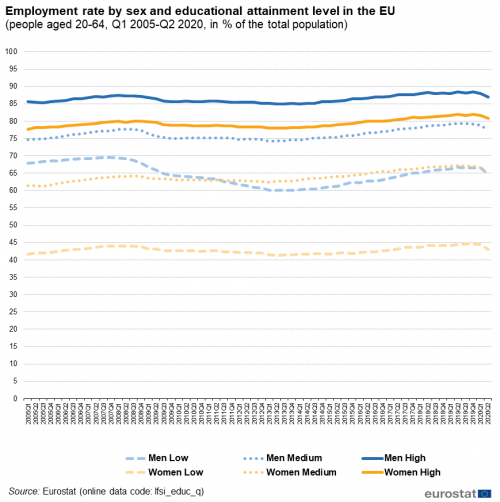
(people aged 20-64, Q1 2005 - Q2 2020, in % of the total population)
Source: Eurostat (lfsi_educ_q)
Sharp decrease in temporary contracts in most EU Member States, different patterns for part-time employment
Losses in employment mainly due to the fall in temporary contracts
Slightly more than one out of 10 employed persons in the EU-27 were employed under temporary contracts in Q2 2020, precisely 10.2 %, against 11.6 % in Q4 2019. From Q2 2013 to Q2 2017, temporary contracts had a slight positive trend, reaching 23.4 million people and accounting for 12.5 % of the total employment from Q2 2017 to Q4 2017. Since then, the proportion of temporary contracts in the total employment showed a slight downward trend and went down to 11.3 % in Q1 2020. From Q1 2020 to Q2 2020, this proportion of temporary contracts fell sharply to 10.2 % of the total employment in Q2 2020 (-1.1 p.p.), corresponding to 19.2 million persons (see Figure 9).
In the European Union, the number of employed people dropped by 3.8 million from the last quarter of 2019 to the second quarter of 2020. Specifically, the number of employed people with temporary contracts shrank by 3.0 million, falling from 22.2 to 19.2 million. The fall in temporary contracts represents 80.5 % of the total decrease in employment. This also contributed to emphasize the decline in youth employment. Indeed, in the second quarter of 2020, young people aged 15-24 accounted for 29.1% of the total temporary contracts but for 7.6% of the total employment among people aged 15-64. Reciprocally, 46.2 % in the last quarter of 2019 and 42.7% in the second quarter 2020 of employed young people had temporary contracts. This phenomenon, in addition to the expected decrease in hiring, might have strongly impacted the youth employment (see detailed figures in the ![]() here also available under the section "Source data for tables and graphs" below).
here also available under the section "Source data for tables and graphs" below).

(people aged 20-64, Q1 2008 - Q2 2020, in thousand persons)
Source: Eurostat (lfsi_pt_q)
Among the EU Member States (except Germany for which data is not available), Spain (18.6 %), Poland (14.6 %) and Portugal (14.3 %) registered the highest shares of temporary contracts in Q2 2020, each exceeding 14% of the total employment (see Figure 10).
Between the last quarter of 2019 and the second quarter of 2020, 24 out of 26 EU countries registered a decrease in the share of temporary contracts in the total employment. At EU level, it decreased by 1.4 p.p. In Denmark, the proportion of temporary contracts faintly grew from 8.5 % to 8.7 % (+0.2 p.p.). In Lithuania, the proportion remained stable at 0.9 %. By contrast, the sharpest decreases were reported in Spain (-3.1 p.p.), Portugal (-2.9 p.p.), Slovenia (-2.6 p.p.), Croatia (-2.3 p.p.) and Malta (-2.1 p.p.).
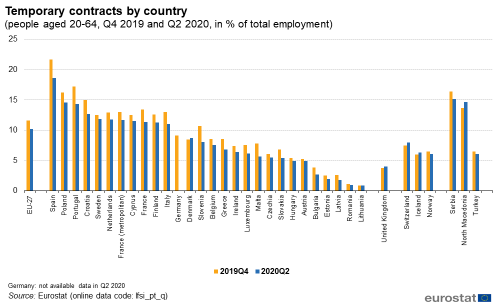
(people aged 20-64, Q4 2019 and Q2 2020, in % of total employment)
Source: Eurostat (lfsi_pt_q)
Fewer part-time workers in a majority of EU Member States
In the EU-27, 31.0 million people reported part-time employment in the second quarter of 2020, corresponding to 16.5 % of the total employment (see Figure 11). From Q1 2008 to Q1 2015, the overall upward trend of part-time employment is relatively smooth and continued: part-time employment accounted for 29.5 million people, corresponding to 15.9 % of the total employment, in the first quarter of 2008, and reached 33.2 million, corresponding to 18.3 % of the total employment, in the first quarter of 2015. From Q2 2015 onward, the proportion of part-time workers slightly decreased although the number of these workers itself might have increased.
Based on the 26 EU Member States for which data is available, the proportion of part-time workers in the total employment grew in 10 countries, was stable in one and dropped in 15 countries between Q4 2019 and Q2 2020. The sharpest decreases were observed in Ireland (-2.4 p.p.), Malta (-1.7 p.p.), Spain (-1.4 p.p.) and Finland (-1.1 p.p.). By contrast, the proportion of part-time workers in the total employment registered an increase of around 1 p.p. in Hungary (+1.2 p.p.), in the Netherlands (0.8 p.p.) and in Luxembourg (+0.7 p.p.).
Another relevant aspect related to part-time employment is the underemployed part-time workers; these are persons working part-time, wishing to work additional hours and are available to do so. At EU level, underemployed part-time workers accounted for 3.1 % of the total employment in Q4 2019 and for 3.2 % in Q2 2020. Nevertheless, at country level, the share of underemployed part-time workers decreased by 0.5 p.p. or more in Malta, Spain and Belgium, reaching 0.8 %, 5.3 % and 3.0 % of the total employment respectively. By contrast, rises higher than 0.5 p.p. in the proportion of underemployed part-time workers in the total employment were observed in Italy (+1.5 p.p.) and the Netherlands (+0.7 p.p.), reaching 4.4 % and 4.2 % respectively.
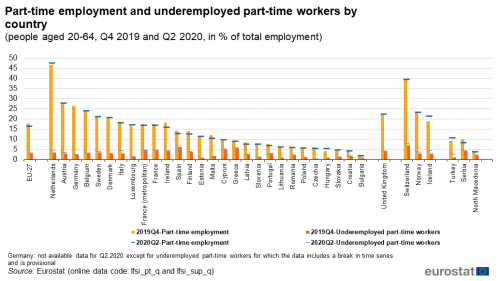
(people aged 20-64, Q4 2019 and Q2 2020, in % of total employment)
Source: Eurostat (lfsi_pt_q) and (lfsi_sup_q)
Source data for tables and graphs
Data sources
All figures in this article are based on seasonally adjusted quarterly results from the European Labour Force Survey (EU-LFS).
Source: The European Union Labour Force Survey (EU-LFS) is the largest European household sample survey providing quarterly and annual results on labour participation of people aged 15 and over as well as on persons outside the labour force. It covers residents in private households. Conscripts in military or community service are not included in the results. The EU-LFS is based on the same target populations and uses the same definitions in all countries, which means that the results are comparable between countries.
European aggregates: EU refers to the sum of the 27 EU Member States.
Country note: Due to technical issues with the introduction of the new German system of integrated household surveys, including the Labour Force Survey (LFS), the figures for Germany for the first and second quarter 2020 are not direct estimates from LFS microdata, but based on a larger sample including additional data from other integrated household surveys. A restricted set of indicators has been estimated and used for the production of the LFS Main Indicators. These estimates have also been used in the calculation of EU and EA aggregates, and are published for some selected indicators (estimates for Germany are flagged as p – provisional, and u – unreliable). For more information, see here.
Definitions: The concepts and definitions used in the Labour Force Survey follow the guidelines of the International Labour Organisation.
Five different articles on detailed technical and methodological information are linked from the overview page of the online publication EU Labour Force Survey.
Context
The COVID-19 health crisis hit Europe in January and February 2020, with the first cases confirmed in Spain, France and Italy. COVID-19 infections have now been diagnosed in all European Union (EU) Member States. To fight the pandemic, EU Member States have taken a wide variety of measures. From the second week of March, most countries closed retail shops apart from supermarkets, pharmacies and banks. Bars, restaurants and hotels have also been closed. In Italy and Spain, non-essential production was stopped and several countries imposed regional or even national lock-down measures which further stifled the economic activities in many areas. In addition, schools were closed, public events were cancelled and private gatherings (with numbers of persons varying from 2 to 50) were banned in most Member States.
The large majority of the prevention measures were taken during mid-March 2020 and most of the prevention measures and restrictions were kept for the whole of April and May 2020. The second quarter of 2020 is consequently the quarter in which the labour market across the EU has been strongly affected by COVID-19 measures taken by the Member States.
Employment and unemployment as defined by the ILO concept are, in this particular situation, not sufficient to describe the developments taking place in the labour market. In this first phase of the crisis, active measures to contain employment losses led to absences from work rather than dismissals, and individuals could not search for work or were not available due to the containment measures, thus not counting as unemployed.
The quarterly data on employment will allow along the quarters to report on the impact of the crisis due to the COVID-19 pandemic on employment. This specific article focuses on the age and the level of education attainment of employed people in order to determine potential categories more or less affected by the economic downturn. It also shows the evolution of part-time employment and temporary contracts. Another article on the evolution of employment by activity and professional status is also available in the context of the publication Labour market in the light of the COVID-19 pandemic.
Direct access to
- All articles on employment
- Labour market in the light of the COVID 19 pandemic - quarterly statistics
- Employment rates and Europe 2020 national targets
- Job vacancy statistics
- Labour market statistics at regional level
- People outside the labour force
- The EU in the world - labour market
- Labour market slack – annual statistics on unmet needs for employment
- LFS main indicators (t_lfsi)
- Population, activity and inactivity - LFS adjusted series (t_lfsi_act)
- Employment - LFS adjusted series (t_lfsi_emp)
- Unemployment - LFS adjusted series (t_une)
- LFS series - Detailed annual survey results (t_lfsa)
- LFS series - Specific topics (t_lfst)
- LFS main indicators (lfsi)
- Employment and activity - LFS adjusted series (lfsi_emp)
- Unemployment - LFS adjusted series (une)
- Labour market transitions - LFS longitudinal data (lfsi_long)
- LFS series - Detailed quarterly survey results (from 1998 onwards) (lfsq)
- LFS series - Detailed annual survey results (lfsa)
- LFS series - Specific topics (lfst)
- LFS ad-hoc modules (lfso)
Publications
- EU labour force survey — online publication
- Labour Force Survey in the EU, candidate and EFTA countries — Main characteristics of national surveys, 2017, 2018 edition
- Quality Report of the European Union Labour Force Survey 2017, 2019 edition
ESMS metadata files and EU-LFS methodology
- Employment and unemployment (Labour Force Survey) (ESMS metadata file — employ_esms)
- Employment growth and activity branches - annual averages (ESMS metadata file — lfsi_grt_a_esms)
- LFS ad-hoc modules (ESMS metadata file — lfso_esms)
- LFS main indicators (ESMS metadata file — lfsi_esms)
- LFS series - Detailed annual survey results (ESMS metadata file — lfsa_esms)
- LFS series - detailed quarterly survey results (from 1998 onwards) (ESMS metadata file — lfsq_esms)
